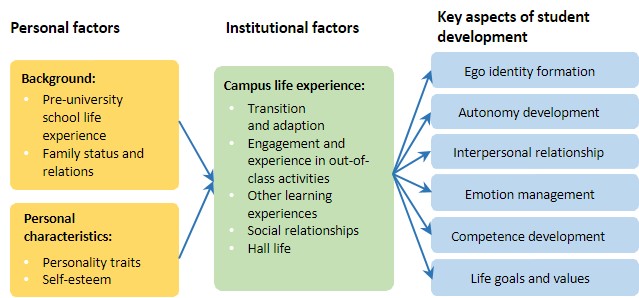Longitudinal Study III
A longitudinal study on the effect of campus life experience in student development in undergraduate years (2014 – 2020)
In the two previous longitudinal studies conducted by CELT, the focus of the investigation was on students’ academic experience and its related cognitive learning outcomes. However, the purpose of university education is not limited to the development of academic and professional skills and knowledge. Students’ social skills, psychosocial development, values and attitudes (referred to as student development hereafter) are also learning outcomes of crucial importance to undergraduate education. Hence with funding from the University, a study which focuses on students’ out-of-class and campus life experiences, and their impact on student development is now being launched.
This study aims to fill a gap in our knowledge about UG students’ campus life experience, and its influence on selected key aspects of student development. Figure 1 below summarizes the key constructs that are identified from the literature and will be studied in this study.
Figure 1: The key constructs of this study

In particular, we aim to
provide a portrait of the selected key aspects of student development at HKUST throughout the entire UG curriculum;
examine the interrelationships of such development with students’ campus life experience, as well as selected background and personal characteristics; and
investigate the unique contribution of campus life experience to the development of key graduate attributes, namely intercultural competence, teamwork skills, and creativity.
Data collection
Both quantitative and qualitative data will be collected through surveys and interviews. Participants will be invited to complete questionnaire surveys once every term. Data will also be collected through psychological inventories and tests. A small number of participants will be invited to participate in one-on-one interviews.
Sample
The research sample will consist of 450 year 1 students selected from the 2014/2015 cohort using a stratified random sampling method with school affiliation as the stratifying variable.
- 2346 reads
